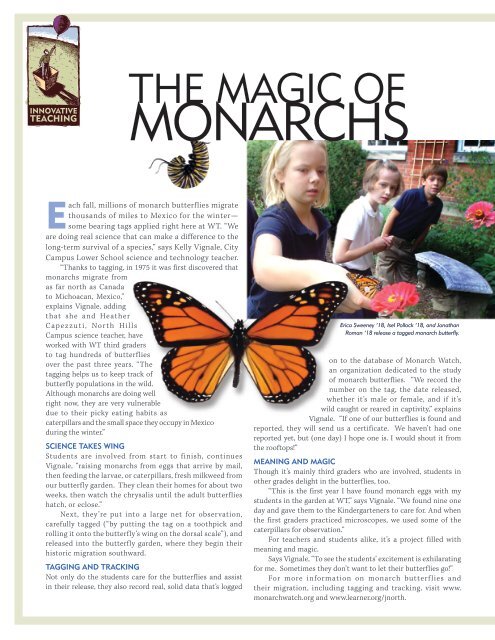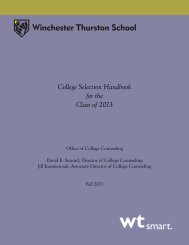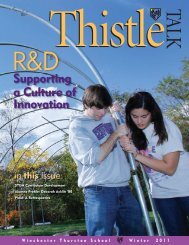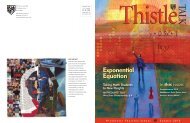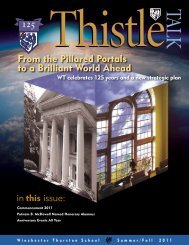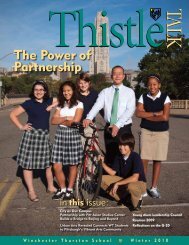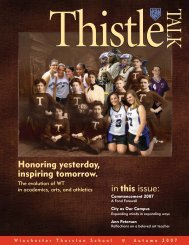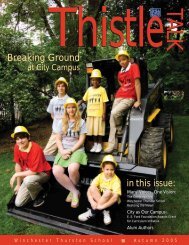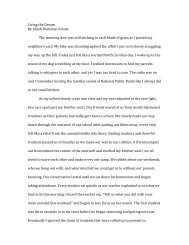Thistletalk Autumn 2008 - Winchester Thurston School
Thistletalk Autumn 2008 - Winchester Thurston School
Thistletalk Autumn 2008 - Winchester Thurston School
- No tags were found...
Create successful ePaper yourself
Turn your PDF publications into a flip-book with our unique Google optimized e-Paper software.
The Magic ofMonarchsEach fall, millions of monarch butterflies migratethousands of miles to Mexico for the winter—some bearing tags applied right here at WT. “Weare doing real science that can make a difference to thelong-term survival of a species,” says Kelly Vignale, CityCampus Lower <strong>School</strong> science and technology teacher.“Thanks to tagging, in 1975 it was first discovered thatmonarchs migrate fromas far north as Canadato Michoacan, Mexico,”explains Vignale, addingthat she and HeatherCapezzuti, North HillsCampus science teacher, haveworked with WT third gradersto tag hundreds of butterfliesover the past three years. “Thetagging helps us to keep track ofbutterfly populations in the wild.Although monarchs are doing wellright now, they are very vulnerabledue to their picky eating habits ascaterpillars and the small space they occupy in Mexicoduring the winter.”Science Takes WingStudents are involved from start to finish, continuesVignale, “raising monarchs from eggs that arrive by mail,then feeding the larvae, or caterpillars, fresh milkweed fromour butterfly garden. They clean their homes for about twoweeks, then watch the chrysalis until the adult butterflieshatch, or eclose.”Next, they’re put into a large net for observation,carefully tagged (“by putting the tag on a toothpick androlling it onto the butterfly’s wing on the dorsal scale”), andreleased into the butterfly garden, where they begin theirhistoric migration southward.Tagging and TrackingNot only do the students care for the butterflies and assistin their release, they also record real, solid data that’s loggedErica Sweeney ’18, Isel Pollock ’18, and JonathanRoman ’18 release a tagged monarch butterfly.on to the database of Monarch Watch,an organization dedicated to the studyof monarch butterflies. “We record thenumber on the tag, the date released,whether it’s male or female, and if it’swild caught or reared in captivity,” explainsVignale. “If one of our butterflies is found andreported, they will send us a certificate. We haven’t had onereported yet, but (one day) I hope one is. I would shout it fromthe rooftops!”Meaning and MagicThough it’s mainly third graders who are involved, students inother grades delight in the butterflies, too.“This is the first year I have found monarch eggs with mystudents in the garden at WT,” says Vignale. “We found nine oneday and gave them to the Kindergarteners to care for. And whenthe first graders practiced microscopes, we used some of thecaterpillars for observation.”For teachers and students alike, it’s a project filled withmeaning and magic.Says Vignale, “To see the students’ excitement is exhilaratingfor me. Sometimes they don’t want to let their butterflies go!”For more information on monarch butterflies andtheir migration, including tagging and tracking, visit www.monarchwatch.org and www.learner.org/jnorth.10 T h i s t l e t a l k A u t u m n / W i n t e r 2 0 0 8


